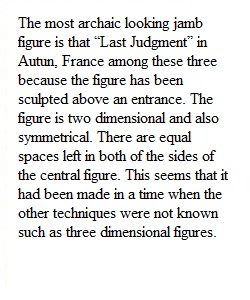


Q Jamb figures are just one small part of the overall design of a Medieval church portal. Another significant area occurs right above the doorway, and it is called the tympanum. Very often, the figure of Christ is featured centrally within the tympanum. Starting with what you know about the way that jamb figures have evolved over time (as discussed in Anthony's video and in the course text), take a look at the three images at the bottom of this page, two of which are drawn directly from tympana, while the third is from a trumeau, and all of which depict the figure of Christ. One of the themes we're interested in is how the idea of the Christian godhead was changing over time, from remote to accessible. Start by taking a close look at how Christ is represented in each of the three sculptures. Compare and contrast these depictions, and sequence them in a way that makes sense in terms of how we have been looking at Greek sculpture, but with an eye toward understanding how the godhead is relating to the human observer. Think about what these depictions tell us about a changing relationship between humans and the godhead. In other words, which Christ figure appears to come closest to us as observers, and why? What are the actual formal characteristics of the sculpture that make the Christ figure appear closer to us, or more remote? Which of the three seems most Archaic/Early Gothic (in other words, first phase of evolution) in the depiction of Christ? Which one feels closer to the Classical/High Gothic (in other words, second phase of evolution)? Which is most Hellenistic/Late Gothic (in other words, third phase of evolution)? Begin by determining a definite order, and name the sculptures when defining that order. Then explain, by citing concrete details in the sculptures, why that order makes sense to you. Do not just state that a certain piece seems more open or closed than another, but explain why, using direct reference to the sculptures themselves. Point to specific features. When you are discussing these sculptures, or any works of art, refer to them by name, so we know which one you are talking about. (For example: "In the example of the Autun tympanum, Christ is depicted . . . ") Also, pretend that you see these sculptures but that your reader cannot, as if you have to read your description to them over the phone, so that they can visualize what you are saying. This will help you to understand what it means to use rich detail in a specific way in your descriptions, here and throughout the course. Again, keep in mind that what defines those three periods of Greek (or any) art is not so much stylistic as it is a much broader phenomenon, which starts with spatial behavior, and includes the degree of relative openness/relative closure, idealism/realism, and geometry/location/orientation of the figures, as well as the overall spatial context.
View Related Questions